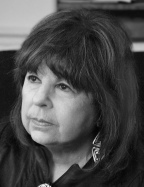Special Feature on Lara Gularte
 The Bitter Oleander‘s latest issue contains a special feature on Lara Gularte which includes a bio, interview, and selection of her poetry. Born in 1947 and raised in San Jose, California, Gularte has a unique family history as well as an accomplished self history. In the interview, she speaks much to how her experiences growing up influenced her life as a writer: “I remember having an active imagination that grew greater due to my isolation and no other children to socialize with. . . . I was so used to amusing myself and spending time with adults, grade school was a formidable experience. However, my love of reading stories never waned.” By high school, she was interested in “Beat Poets” and had the opportunity to buy a book of poetry from and meet Lawrence Ferlinghetti. She participated in demonstrations and was part of the counter culture movement. More influences include working in human services, participating in a group called “Waverly Writers,” attending Community of Writers Squaw Valley Workshop, and going to the DISQUIET International Literary Program in Lisbon, Portugal.
The Bitter Oleander‘s latest issue contains a special feature on Lara Gularte which includes a bio, interview, and selection of her poetry. Born in 1947 and raised in San Jose, California, Gularte has a unique family history as well as an accomplished self history. In the interview, she speaks much to how her experiences growing up influenced her life as a writer: “I remember having an active imagination that grew greater due to my isolation and no other children to socialize with. . . . I was so used to amusing myself and spending time with adults, grade school was a formidable experience. However, my love of reading stories never waned.” By high school, she was interested in “Beat Poets” and had the opportunity to buy a book of poetry from and meet Lawrence Ferlinghetti. She participated in demonstrations and was part of the counter culture movement. More influences include working in human services, participating in a group called “Waverly Writers,” attending Community of Writers Squaw Valley Workshop, and going to the DISQUIET International Literary Program in Lisbon, Portugal.
In response to the question in which Gularte admits is “very thought provoking and not easy to answer”—”Your poems are enriched by an imagism . . . and a solitude that summons both the natural world and the consciousness that helps complete your oneness with it . . . How do you manage to keep it awake inside yourself?”—Gularte writes, “I look at writing poetry as mining, going into my unconscious to draw out what is there and make sense of it . . . I can enter the unconscious easily at any time. However, I must be quiet and not have busy activities to do. From my unconscious I retrieve images. I am a visual person and find putting images to words is satisfying for me. Before I write a poem I retrieve many images from my unconscious and describe these images on paper. I then put the images together to make some kind of sense. I never know what will come of it. I arrange words with a result that usually surprises me. I like to be surprised.”
Here’s a sample of some of her work. The poem is titled “Cassandra Visits the Azores”:
She roams the stone islands,
sees the future through basaltic rock-
flowings, wrinkled crevasses, hardened fluids.Her milky eyes never shut.
She wears a necklace of black stones,
these stones she throws in the sea,
and fishing boats, surface.The folding and unfolding
of what she sees turns her inward,
sand and tears stream down her face.The sky of wayward gray slides like lava,
light changing,
changing moments.Water spills over the caldera.
